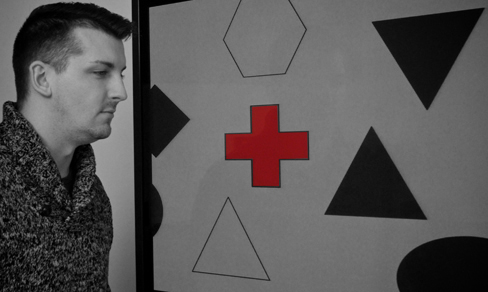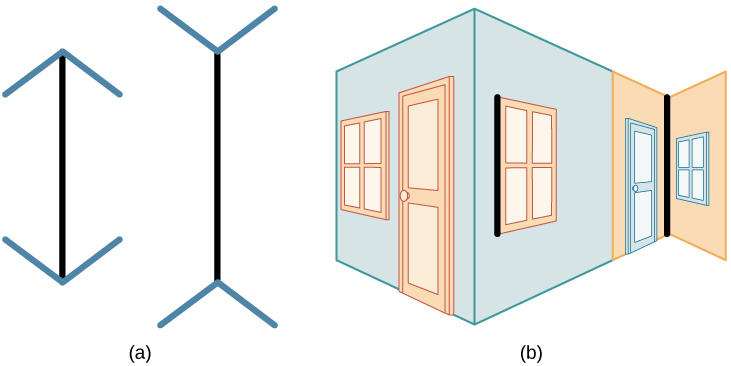What is Perception?
Learning Objectives
- Discuss the roles attention, motivation, and sensory adaptation play in perception
While our sensory receptors are constantly collecting information from the environment, it is ultimately how we interpret that information that affects how we interact with the world. Perception refers to the way sensory information is organized, interpreted, and consciously experienced. Perception involves both bottom-up and top-down processing. Bottom-up processing refers to sensory information from a stimulus in the environment driving a process, and top-down processing refers to knowledge and expectancy driving a process, as shown in Figure 5.2 (Egeth & Yantis, 1997; Fine & Minnery, 2009; Yantis & Egeth, 1999).
Look at the shape in Figure 1 below. Seen alone, your brain engages in bottom-up processing. There are two thick vertical lines and three thin horizontal lines. There is no context to give it a specific meaning, so there is no top-down processing involved.

Now, look at the same shape in two different contexts. Surrounded by sequential letters, your brain expects the shape to be a letter and to complete the sequence. In that context, you perceive the lines to form the shape of the letter “B.”

Surrounded by numbers, the same shape now looks like the number “13.”

When given a context, your perception is driven by your cognitive expectations. Now you are processing the shape in a top-down fashion.
One way to think of this concept is that sensation is a physical process, whereas perception is psychological. For example, upon walking into a kitchen and smelling the scent of baking cinnamon rolls, the sensation is the scent receptors detecting the odor of cinnamon, but the perception may be “Mmm, this smells like the bread Grandma used to bake when the family gathered for holidays.”
Although our perceptions are built from sensations, not all sensations result in perception. In fact, we often don’t perceive stimuli that remain relatively constant over prolonged periods of time. This is known as sensory adaptation. Imagine going to a city that you have never visited. You check into the hotel, but when you get to your room, there is a road construction sign with a bright flashing light outside your window. Unfortunately, there are no other rooms available, so you are stuck with a flashing light. You decide to watch television to unwind. The flashing light was extremely annoying when you first entered your room. It was as if someone was continually turning a bright yellow spotlight on and off in your room, but after watching television for a short while, you no longer notice the light flashing. The light is still flashing and filling your room with yellow light every few seconds, and the photoreceptors in your eyes still sense the light, but you no longer perceive the rapid changes in lighting conditions. That you no longer perceive the flashing light demonstrates sensory adaptation and shows that while closely associated, sensation and perception are different.
Review Questions
Attention and Perception
There is another factor that affects sensation and perception: attention. Attention plays a significant role in determining what is sensed versus what is perceived. Imagine you are at a party full of music, chatter, and laughter. You get involved in an interesting conversation with a friend, and you tune out all the background noise. If someone interrupted you to ask what song had just finished playing, you would probably be unable to answer that question.
Watch It
See for yourself how inattentional blindness works by watching this selective attention test from Simons and Chabris (1999):
You can view the transcript for “selective attention test” here (opens in new window).
One of the most interesting demonstrations of how important attention is in determining our perception of the environment occurred in a famous study conducted by Daniel Simons and Christopher Chabris (1999). In this study, participants watched a video of people dressed in black and white passing basketballs. Participants were asked to count the number of times the team dressed in white passed the ball. During the video, a person dressed in a black gorilla costume walks among the two teams. You would think that someone would notice the gorilla, right? Nearly half of the people who watched the video didn’t notice the gorilla at all, despite the fact that he was clearly visible for nine seconds. Because participants were so focused on the number of times the team dressed in white was passing the ball, they completely tuned out other visual information. Inattentional blindness is the failure to notice something that is completely visible because the person was actively attending to something else and did not pay attention to other things (Mack & Rock, 1998; Simons & Chabris, 1999).
In a similar experiment, researchers tested inattentional blindness by asking participants to observe images moving across a computer screen. They were instructed to focus on either white or black objects, disregarding the other color. When a red cross passed across the screen, about one third of subjects did not notice it (Figure 5.3) (Most, Simons, Scholl, & Chabris, 2000).
Link to Learning
Read more on inattentional blindness at the Noba Project website.

Motivations, Expectations, and Perception
Motivation can also affect perception. Have you ever been expecting a really important phone call and, while taking a shower, you think you hear the phone ringing, only to discover that it is not? If so, then you have experienced how motivation to detect a meaningful stimulus can shift our ability to discriminate between a true sensory stimulus and background noise. The ability to identify a stimulus when it is embedded in a distracting background is called signal detection theory. This might also explain why a mother is awakened by a quiet murmur from her baby but not by other sounds that occur while she is asleep. Signal detection theory has practical applications, such as increasing air traffic controller accuracy. Controllers need to be able to detect planes among many signals (blips) that appear on the radar screen and follow those planes as they move through the sky. In fact, the original work of the researcher who developed signal detection theory was focused on improving the sensitivity of air traffic controllers to plane blips (Swets, 1964).
Our perceptions can also be affected by our beliefs, values, prejudices, expectations, and life experiences. As you will see later in this module, individuals who are deprived of the experience of binocular vision during critical periods of development have trouble perceiving depth (Fawcett, Wang, & Birch, 2005). The shared experiences of people within a given cultural context can have pronounced effects on perception. For example, Marshall Segall, Donald Campbell, and Melville Herskovits (1963) published the results of a multinational study in which they demonstrated that individuals from Western cultures were more prone to experience certain types of visual illusions than individuals from non-Western cultures, and vice versa. One such illusion that Westerners were more likely to experience was the Müller-Lyer illusion (Figure 5): The lines appear to be different lengths, but they are actually the same length.

These perceptual differences were consistent with differences in the types of environmental features experienced on a regular basis by people in a given cultural context. People in Western cultures, for example, have a perceptual context of buildings with straight lines, what Segall’s study called a carpentered world (Segall et al., 1966). In contrast, people from certain non-Western cultures with an uncarpentered view, such as the Zulu of South Africa, whose villages are made up of round huts arranged in circles, are less susceptible to this illusion (Segall et al., 1999). It is not just vision that is affected by cultural factors. Indeed, research has demonstrated that the ability to identify an odor, and rate its pleasantness and its intensity, varies cross-culturally (Ayabe-Kanamura, Saito, Distel, Martínez-Gómez, & Hudson, 1998).
Children described as thrill seekers are more likely to show taste preferences for intense sour flavors (Liem, Westerbeek, Wolterink, Kok, & de Graaf, 2004), which suggests that basic aspects of personality might affect perception. Furthermore, individuals who hold positive attitudes toward reduced-fat foods are more likely to rate foods labeled as reduced fat as tasting better than people who have less positive attitudes about these products (Aaron, Mela, & Evans, 1994).
Watch It
Review the differences between sensation and perception in this CrashCourse Psychology video:
Review Questions
Think It Over
Think about a time when you failed to notice something around you because your attention was focused elsewhere. If someone pointed it out, were you surprised that you hadn’t noticed it right away?
attributions
Original content. Provided by: Lumen Learning. License: CC BY: Attribution
Sensation and Perception. Authored by: OpenStax College. License: CC BY: Attribution.
Section on bottom-up versus top-down processing. Authored by: Dr. Scott Roberts, Dr. Ryan Curtis, Samantha Levy, and Dr. Dylan Selterman. License: CC BY-NC-SA: Attribution-NonCommercial-ShareAlike
Sensation & Perception – Crash Course Psychology #5. Provided by: CrashCourse. License Terms: Standard YouTube License
way that sensory information is interpreted and consciously experienced
system in which perceptions are built from sensory input
interpretation of sensations is influenced by available knowledge, experiences, and thoughts
the reduction in sensitivity after prolonged exposure to a stimulus
failure to notice something that is completely visible because of a lack of attention
perception: way that sensory information is interpreted and consciously experienced

